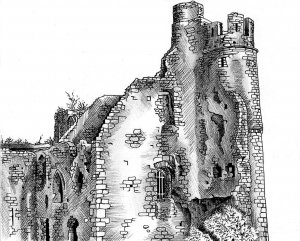I am unsure where I would stand for publication if I published every chapter of the biography on the web first, so while I find out, here is the Introduction to whet your appetite.
Introduction
 This story began when I stood one day outside Swansea Castle and wondered what it looked like in its heyday. What I discovered when I started finding out, led me deeper into history than I had ever gone before. History was not a subject I enjoyed in school, but these became real people to me, and I was fascinated. My research also showed me some things about Swansea that I never suspected. I always assumed that, other than being a good port, Swansea was not very important that far back in history. But I discovered that the owner of Swansea Castle was pivotal in the rebellion which toppled the king of England.
This story began when I stood one day outside Swansea Castle and wondered what it looked like in its heyday. What I discovered when I started finding out, led me deeper into history than I had ever gone before. History was not a subject I enjoyed in school, but these became real people to me, and I was fascinated. My research also showed me some things about Swansea that I never suspected. I always assumed that, other than being a good port, Swansea was not very important that far back in history. But I discovered that the owner of Swansea Castle was pivotal in the rebellion which toppled the king of England.
I am using the life of Alina de Mowbray to tell this story, as it gives the opportunity to look at the actions of both her father and her husband, as well as the trials of life in the early fourteenth century, a period which popular history seldom covers. To those familiar with Swansea and Gower, this story will be of great interest, but also for others it will give a different perspective on this turbulent time for Wales and for England.
The first four chapters set the scene, before coming to the key events of the story. Chapter one covers Alina’s early life, based on records of her father and what life was typically like for the aristocracy in the late thirteenth century. Chapter two gives the background of the family and more on her father. Chapter three looks at the physical setting, especially the two main castles of Swansea and Oystermouth.
Alina’s father, William de Breos, fought for Edward I in his defeat of the Prince of Wales. Chapter four covers this important point in history. From then, Wales was never again independent. The Welsh marches were conquered soon after England, and had been part of England since then. These Norman lords supplied men and weapons to assist the king in his many wars, at home and abroad. Even when Wales was created as a Principality, the marches were not included.
Edward I was a champion, his son Edward II was the complete opposite. From chapter five onwards the story unfolds of William de Breos’s troubles and schemes which eventually led to the rebellion of his son in law, attempting to protect Alina’s inheritance. That local rebellion, like a rolling snowball, gathered other barons in a country-wide uprising against a weak and distrusted king. When the queen herself led an army against him, it was to Wales that he fled.
 Ann Marie Thomas is the author of four medieval history books, a surprisingly cheerful poetry collection about her 2010 stroke, and the science fiction series Flight of the Kestrel. Book one, Intruders, and book two Alien Secrets, are out now. Follow her at http://eepurl.com/bbOsyz
Ann Marie Thomas is the author of four medieval history books, a surprisingly cheerful poetry collection about her 2010 stroke, and the science fiction series Flight of the Kestrel. Book one, Intruders, and book two Alien Secrets, are out now. Follow her at http://eepurl.com/bbOsyz